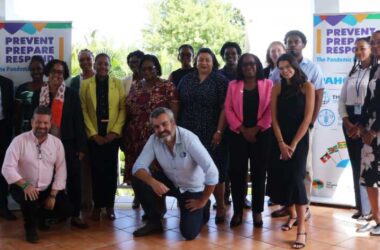THE Department of Agriculture, Fisheries, Natural Resources and Co-operatives is calling on stakeholders in the south of the island to take certain actions to mitigate damage to crops and livestock in light of the volcano eruption in Saint Vincent and the Grenadines.
The Department says it has been advised that there will be a strong possibility Saint Lucia, particularly the south of the island, will be impacted with ash, low visibility and air quality issues.
The Department advised stakeholders to take the following mitigation actions.
Crop Cultivators
Mature/ripe above ground crops close to harvest are particularly vulnerable to contamination, pollination disruption and damage. Under very thin ash falls (< 1 mm) crops can suffer from acid damage or reduced UV light and, with increasing thicknesses, plants may be broken or buried and soil potentially smothered.
1. Crop cultivators should immediately review and update inventory of established crops
2. Harvest and store vegetables, fruits and vegetables that are mature and ready for markets
3. Secure auxiliary water supplies including coverage of irrigation ponds. Where possible store water in sealed tanks for irrigation
4. Bearing in mind that farmers may need to venture out to assess damage and loss, use respirators to reduce chances of respiratory contamination
5. Secure and adequately protect from the elements and from the effects of falling volcanic ash farm equipment including water pumps and tillage equipment.
Livestock Producers
The impact of ash and gases from a volcanic eruption is potentially devastating on the livestock sector. Depending on the thickness of the ash and the levels of soluble fluorine in the ash, fluorine poisoning (Fluorosis) and death can occur in livestock that graze on ash-covered pastures. Other possible metabolic disorders can occur; respiratory issues can develop from inhalation of particles and exposure to fluorine as well as eye and skin irritation and abrasion of teeth and hooves resulting in reduced productivity and losses. Volcanic ash will also harm honeybees and negatively affect honey quality.
Ashfall can destroy pastures, forages and other plants used to feed livestock and bees. Uncontaminated feed will be in short supply if there is inadequate preparation. Shortages of feed and water for livestock will inevitably lead to starvation, loss of production and ultimately death.
Livestock farmers, especially those in the south of the island, are therefore advised to take all necessary steps to protect their livestock. This includes:
1. Proper storage of adequate amounts of feed to be able to sustain animals for at least 2 weeks post disaster.
2. Ruminant farmers are encouraged to start harvesting and storing feed, forage and/or fodder.
3. Farmers should maintain proper storage facilities or quarters to house water, feed, hay or silage.
4. Beekeepers should store feed for bees (sugar) in the event that natural food sources are destroyed
5. Farmers must ensure that they can store sufficient clean drinking water for their livestock for at least 2 weeks.
6. Protect animals from falling ash
7. Identify areas of shelter/protection from ashfall for free range animals like small ruminants and cattle.
8. Farmers must ensure that farm equipment if adequately protected from the elements and from the effects of falling volcanic ash.
Fisheries
1. The impact of ash and gases from a volcanic eruption can affect the ability of fishers to navigate safely out at sea. Fishers are advised to
2. Ensure that their fishing licenses are valid and vessels registered
3. If ashfall increases, vessels should be pulled to shore and covered along with fishing gear
4. If fishers venture out to sea, carry all safety equipment and ensure these are in good working order
The Department further advised that all Fishers and Farmers remain vigilant and listen to official sources of information. All relevant updates and guidance will be provided as more information on the status of volcanic activity in Saint Vincent and the Grenadines becomes available.













